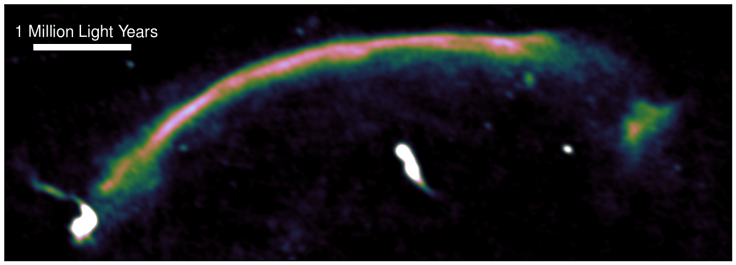Cosmic tsunami gives sleeping galaxies new lease of life

Shock waves generated when clusters of galaxies merge can briefly bring alive "dead" galaxies that have stopped producing stars, say astronomers who observed the process in a galaxy cluster nicknamed the Sausage.
Located 2.3 billion light years away in the direction of the constellation of Lacerta, in the northern hemisphere of the sky, the cluster CIZA J2242.8+5301 in the process of merging triggered a new wave of star formation.
The international team of astronomers, led by Andra Stroe of Leiden Observatory and David Sobral of Leiden and the University of Lisbon, watched the event using the Isaac Newton and William Herschel Telescopes on La Palma, and the Subaru, CFHT and Keck Telescopes on Hawaii.
However, the stars formed under such impacts are massive and shortlived and hence, die soon in supernovae a few million years later. The explosions drive huge amounts of remaining gas out of the galaxies and soon enough the galaxies run out of fuel and go back to their comatose state.
Prospects of a second resurrection are low, says Stroe.
The scientists published their work in the journal Monthly Notices of the Royal Astronomical Society.
Galaxy clusters are densely packed regions containing thousands of galaxies. Over billions of years, they merge with adjacent clusters with a huge release of energy. The resulting shock wave travels through the cluster like a tsunami, but until now there was no evidence that the galaxies themselves were affected very much.
Stroe says: "We assumed that the galaxies would be on the sidelines for this act, but it turns out they have a leading role. The comatose galaxies in the Sausage cluster are coming back to life, with stars forming at a tremendous rate. When we first saw this in the data, we simply couldn't believe what it was telling us."
He likens cluster mergers to the stirring of a coffee mug, with the shocks causing turbulence in the galactic gas. These in turn trigger an avalanche-like collapse, which eventually leads to the formation of very dense, cold gas clouds, needed for the formation of new stars.
Every cluster of galaxies near us has experienced a series of mergers during its lifetime. As the shocks lead to a brief increase in star formation, astronomers have to catch the cluster at a time in its evolution when the galaxies are still being "lit up" by the shock.
The team now plans to see if the Sausage cluster is unique, requiring specific conditions or universal. They will study a much bigger sample of galaxies to check that.
© Copyright IBTimes 2025. All rights reserved.





















